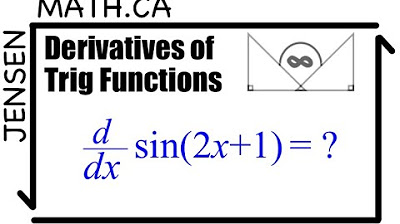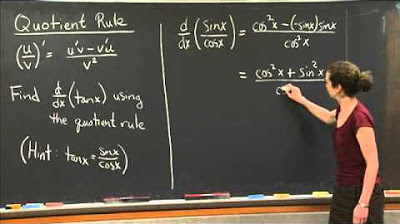How To Find The Derivative of Sin^2(x), Sin(2x), Sin^2(2x), Tan3x, & Cos4x
TLDRThe video script offers a comprehensive guide on calculating derivatives of common trigonometric functions, essential for homework or test preparation. It explains the process step-by-step, starting with basic functions like the derivative of sine(2x) and tangent(3x), and progressing to more complex examples such as the derivative of sine squared(2x) and sine(tangent(x squared)). The method involves finding the derivative of the outer function, handling the inner function, and applying the chain rule and properties of trigonometric identities. The script is an informative resource for those looking to enhance their understanding of derivatives in trigonometry.
Takeaways
- 📚 The derivative of sin(2x) is 2cos(2x), found by applying the chain rule to the sine function and differentiating 2x.
- 📈 The derivative of tan(3x) is 3sec^2(3x), using the derivative of the tangent function (sec^2) and the derivative of the inner function (3x).
- 🌟 The derivative of cos(4x) is -4sin(4x), keeping the angle the same for the cosine function and applying the derivative to 4x.
- 🔍 To find the derivative of (sin(2x))^2, rewrite the expression as 2sin(2x) - 1 and apply the chain rule to the exponent, resulting in 4sin(2x)cos(2x).
- 📝 For the derivative of sin^2(x), simplify the expression by moving the exponent to the outside and applying the chain rule, leading to 2sin(x)cos(x).
- 🤔 The derivative of sin(tan(x^2)) involves differentiating both the sine and tangent functions, resulting in 2xsec^2(x^2)cos(x^2).
- 📊 The process of finding derivatives of trigonometric functions often involves the chain rule and understanding the basic derivatives of trigonometric functions like sine and cosine.
- 🔧 The use of the chain rule is crucial for differentiating composite functions, which is a common scenario in calculus problems involving trigonometric functions.
- 🧩 When dealing with trigonometric functions, it's important to keep track of the angle transformations and the corresponding derivatives.
- 📐 The derivatives of trigonometric functions are fundamental in solving calculus problems and can be applied in various areas of mathematics and physics.
Q & A
What is the derivative of sine of 2x?
-The derivative of sine of 2x is 2 cosine of 2x. This is found by first recognizing that the derivative of sine is cosine, and then applying the chain rule to account for the 2x, resulting in 2 multiplied by the derivative of cosine at 2x, which is 2 cosine of 2x.
How do you find the derivative of tangent of 3x?
-The derivative of tangent of 3x is 3 secant squared of 3x. This is calculated by first identifying the derivative of tangent as secant squared, and then using the chain rule for the 3x, which gives us 3 multiplied by the derivative of secant squared at 3x.
What is the derivative of cosine of 4x?
-The derivative of cosine of 4x is negative 4 sine of 4x. This is derived by recognizing that the derivative of cosine is negative sine, and then applying the chain rule to the 4x, resulting in -4 times the derivative of sine at 4x, which is -4 sine of 4x.
How does the video suggest simplifying the derivative of sine squared of 2x?
-The video suggests simplifying the derivative of sine squared of 2x by first rewriting the expression as if sine of 2x were raised to the power of 2. This allows you to treat the 2 as an exponent, which when differentiated using the power rule becomes 2 times sine of 2x. Then, you subtract the exponent by 1 and multiply by the derivative of sine, which is cosine, resulting in 2 cosine of 2x times sine of 2x.
What is the process for finding the derivative of sine squared of x?
-To find the derivative of sine squared of x, you first rewrite the expression as if sine of x were raised to the power of 2. Then, you apply the power rule to move the exponent to the front, subtract the exponent by 1, and finally take the derivative of the inside function, which results in 2 sine of x times cosine of x.
How do you find the derivative of sine of tangent of x squared?
-To find the derivative of sine of tangent of x squared, you first differentiate sine to get cosine, and then differentiate tangent to get secant squared. The angle for the secant squared derivative is x squared. Finally, you multiply the derivative of sine, which is cosine, by the derivative of x squared, which is 2x, and apply the secant squared to x squared, resulting in 2x cosine of tangent of x squared times secant squared of x squared.
What is the chain rule used for in differentiation?
-The chain rule is used in differentiation when you need to differentiate a function that is composed of one function nested inside another. It allows you to break down the process by differentiating the outer function first, then the inner function, and finally combining the results to find the derivative of the entire composite function.
What is the power rule used for in differentiation?
-The power rule is used in differentiation when you need to differentiate a function that involves an exponent. It states that the derivative of x to the power of n is n times x to the power of n minus 1. This rule simplifies the process of differentiating expressions that involve exponents.
Why is it beneficial to rewrite expressions when differentiating?
-Rewriting expressions can make the differentiation process easier and more straightforward. By rearranging terms or factoring out common elements, you can simplify complex expressions and apply differentiation rules more effectively, leading to a clearer path to the final derivative.
What is the significance of the double angle formula in the context of differentiation?
-The double angle formula is significant in differentiation as it allows you to express the derivative of a function involving a squared sine in terms of a product of the original function and another trigonometric function. This simplifies the expression and makes it easier to work with, especially when dealing with composite functions or more complex trigonometric expressions.
How does the video demonstrate the use of trigonometric identities in differentiation?
-The video demonstrates the use of trigonometric identities, such as the double angle formula, in differentiation by showing how they can simplify the process. For example, after differentiating the sine squared expression, the video uses the double angle formula to express the result in a more recognizable form, which can be helpful for further analysis or for checking the solution.
Outlines
📚 Introduction to Derivatives of Trigonometric Functions
This paragraph introduces the topic of finding derivatives of common trigonometric functions. It begins with an example problem, showing how to find the derivative of sine of 2x. The process involves first identifying the derivative of the base function, which is cosine for sine, and then applying the chain rule to the argument (2x), resulting in the final answer of 2 cosine 2x. The paragraph continues with additional examples, such as finding the derivative of tangent 3x and cosine 4x, using similar techniques. It also touches on more complex problems, like finding the derivative of sine squared of 2x, and provides a method for solving such problems by rewriting the expression and applying the power rule.
🔢 Solving Derivatives of Composite Trigonometric Functions
This paragraph delves into solving derivatives of composite trigonometric functions. It starts by addressing the problem of finding the derivative of sine of tangent x squared. The approach involves differentiating the outer function (sine) and the inner function (tangent x squared) separately. The derivative of tangent is secant squared, and the derivative of x squared is 2x. The paragraph then combines these results with the chain rule to arrive at the final answer, which is 2x cosine of tangent x squared times secant squared x squared. The discussion serves as a comprehensive guide on how to tackle more complex trigonometric derivatives by breaking them down into manageable parts.
Mindmap
Keywords
💡derivative
💡trigonometric functions
💡chain rule
💡angle
💡secant
💡exponents
💡differentiation
💡sine
💡cosine
💡tangent
💡power rule
💡double angle formula
Highlights
The video discusses the process of finding derivatives of common trigonometric functions.
Derivative of sine of 2x is found by first recognizing the derivative of sine is cosine.
For the sine of 2x, the angle inside the sine function remains the same as that of the cosine function.
The derivative of 2x is 2, which is applied when finding the derivative of sine of 2x.
The final answer for the derivative of sine of 2x is 2 cosine of 2x.
The derivative of tangent of 3x involves recognizing the derivative of tangent as secant squared.
The angle for the derivative of 3x is 3, leading to the answer 3 secant squared of 3x.
The derivative of cosine is negative sine, which is used to find the derivative of cosine of 4x.
The derivative of 4x is 4, and when combined with the derivative of cosine, the final answer is -4 sine of 4x.
To find the derivative of sine squared of 2x, the problem is rewritten to focus on the exponents.
The derivative of x squared becomes 2x to the first power when differentiating.
The final answer for the derivative of sine squared of 2x is 4 sine of 2x multiplied by cosine of 2x.
For the derivative of sine squared of x, the process involves moving the exponent to the outside and simplifying.
The derivative of 2x is 2, and when combined with the derivative of sine and cosine, the final answer is 2 sine of x times cosine of x.
The derivative of sine of tangent of x squared involves differentiating both the sine and tangent functions.
The derivative of x squared is 2x, and when applied to the tangent function, the final answer is 2x times cosine of tangent of x squared times secant squared of x squared.
Transcripts
Browse More Related Video

Derivative of Inverse Trig Functions via Implicit Differentiation

Derivatives of Trig Functions - Calculus | MCV4U

Evaluating Integrals With Trigonometric Functions

Chain Rule: the Derivative of a Composition

Calculus - Chain Rule - Derivatives

Quotient Rule | MIT 18.01SC Single Variable Calculus, Fall 2010
5.0 / 5 (0 votes)
Thanks for rating: